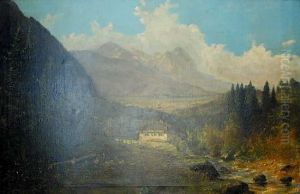Heinrich Ludwig Keller Paintings
Heinrich Ludwig Keller was a significant figure in the Swiss art scene of the 19th century, born in 1829 in Zürich, Switzerland, and passing away in 1890. As an artist, Keller was primarily known for his contributions to painting and watercolor art, focusing on landscapes, cityscapes, and occasionally portraits. His works are characterized by their meticulous attention to detail, vibrant color usage, and the ability to capture the essence of Swiss natural beauty and urban elegance.
Keller's upbringing in the culturally rich environment of Zürich played a crucial role in shaping his artistic journey. He was exposed to art at a young age, and this early fascination laid the groundwork for his future career. The artist pursued formal education in the arts, studying at various prestigious institutions across Europe. This education not only refined his technique but also exposed him to a wide range of artistic styles and movements, which he adeptly incorporated into his unique style.
Throughout his career, Heinrich Ludwig Keller enjoyed considerable success and recognition. He was an active participant in the Swiss art community, contributing to and benefiting from the vibrant cultural exchange of the time. His works were exhibited in numerous galleries and found patronage among the Swiss bourgeoisie, who were keen collectors of his depictions of the Swiss countryside and urban settings.
Keller's legacy extends beyond his paintings. He was instrumental in inspiring a generation of Swiss artists, encouraging them to explore and depict the natural beauty of their homeland. His influence is evident in the way Swiss landscapes and cityscapes were portrayed in art in the subsequent years, marking a significant contribution to the development of Swiss national identity in art.
In retrospect, Heinrich Ludwig Keller's body of work stands as a testament to his profound connection with his Swiss heritage, his mastery over his medium, and his ability to capture and convey the nuanced beauty of his surroundings. His paintings continue to be celebrated for their artistic merit and as historical documents that offer insight into 19th-century Swiss life and landscapes.
